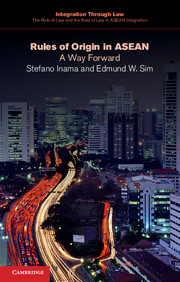Book contents
- Frontmatter
- Contents
- List of Tables
- General Editors’ preface
- Preface
- List of Abbreviations
- Chapter 1 Introduction
- Chapter 2 The initial set of ASEAN rules of origin: the lack of clarity and transparency masquerading as simplicity 1992–1995
- Chapter 3 Externalizing the confusion: the proliferation of rules in the ASEAN FTAs with dialogue partners
- Chapter 4 The silent cost: the cumbersome administration of ASEAN rules of origin
- Chapter 5 The possible way forward: self-certification
- Chapter 6 Conclusion and recommendations
- Executive Summary
- Appendices
- Appendix 1 1992 Agreement on the Common Effective Preferential Tariff Scheme for the ASEAN Free Trade Area
- Appendix 2 Rules of Origin for the CEPT
- Appendix 3 2009 ASEAN Trade in Goods Agreement
- Appendix 4 ATIGA Annex 3, Attachment 1 Substantial Transformation Criterion for Textiles and Textile Products
- Appendix 5 ATIGA Annex 5 Principles and Guidelines for Calculating Regional Value Content on the ATIGA
- Appendix 6 ATIGA Annex 6 Implementing Guidelines for Partial Cumulation under Article 30(2) on ASEAN Cumulative Rules of Origin
- Appendix 7 ATIGA Form D
- Appendix 8 ATIGA Annex 8 Operational Certification Procedure for the Rules of Origin under Chapter 3
- Appendix 9 Rules of Origin, ASEAN–Australia–New Zealand Free Trade Agreement
- Appendix 10 Rules of Origin, ASEAN–China Free Trade Agreement
- Appendix 11 Rules of Origin, ASEAN–India Free Trade Agreement
- Appendix 12 Rules of Origin, ASEAN–Japan Comprehensive Economic Partnership Agreement
- Appendix 13 Rules of Origin, ASEAN–Korea Free Trade Agreement
- Bibliography
- Index
Appendix 10 - Rules of Origin, ASEAN–China Free Trade Agreement
Published online by Cambridge University Press: 05 March 2015
- Frontmatter
- Contents
- List of Tables
- General Editors’ preface
- Preface
- List of Abbreviations
- Chapter 1 Introduction
- Chapter 2 The initial set of ASEAN rules of origin: the lack of clarity and transparency masquerading as simplicity 1992–1995
- Chapter 3 Externalizing the confusion: the proliferation of rules in the ASEAN FTAs with dialogue partners
- Chapter 4 The silent cost: the cumbersome administration of ASEAN rules of origin
- Chapter 5 The possible way forward: self-certification
- Chapter 6 Conclusion and recommendations
- Executive Summary
- Appendices
- Appendix 1 1992 Agreement on the Common Effective Preferential Tariff Scheme for the ASEAN Free Trade Area
- Appendix 2 Rules of Origin for the CEPT
- Appendix 3 2009 ASEAN Trade in Goods Agreement
- Appendix 4 ATIGA Annex 3, Attachment 1 Substantial Transformation Criterion for Textiles and Textile Products
- Appendix 5 ATIGA Annex 5 Principles and Guidelines for Calculating Regional Value Content on the ATIGA
- Appendix 6 ATIGA Annex 6 Implementing Guidelines for Partial Cumulation under Article 30(2) on ASEAN Cumulative Rules of Origin
- Appendix 7 ATIGA Form D
- Appendix 8 ATIGA Annex 8 Operational Certification Procedure for the Rules of Origin under Chapter 3
- Appendix 9 Rules of Origin, ASEAN–Australia–New Zealand Free Trade Agreement
- Appendix 10 Rules of Origin, ASEAN–China Free Trade Agreement
- Appendix 11 Rules of Origin, ASEAN–India Free Trade Agreement
- Appendix 12 Rules of Origin, ASEAN–Japan Comprehensive Economic Partnership Agreement
- Appendix 13 Rules of Origin, ASEAN–Korea Free Trade Agreement
- Bibliography
- Index
Summary
Annex 3 Rules of Origin for the ASEAN–China Free Trade Area
In determining the origin of products eligible for the preferential tariff concession pursuant to the Framework Agreement on Comprehensive Economic Co-operation between the Association of Southeast Asian Nations and the People's Republic of China (hereinafter referred to as “the Agreement”), the following Rules shall be applied:
Rule 1: Definitions
For the purpose of this Annex:
“a Party” means the individual parties to the Agreement i.e. Brunei Darussalam, the Kingdom of Cambodia, the Republic of Indonesia, the Lao People's Democratic Republic (“Lao PDR”), Malaysia, the Union of Myanmar, the Republic of the Philippines, the Republic of Singapore, the Kingdom of Thailand, the Socialist Republic of Vietnam and the People's Republic of China (“China”).
“materials” shall include ingredients, parts, components, subassembly and/or goods that were physically incorporated into another good or were subject to a process in the production of another good.
“Originating goods” means products that qualify as originating in accordance with the provisions of Rule 2.
“production” means methods of obtaining goods including growing, mining, harvesting, raising, breeding, extracting, gathering, collecting, capturing, fishing, trapping, hunting, manufacturing, producing, processing or assembling a good.
“Product Specific Rules” are rules that specify that the materials have undergone a change in tariff classification or a specific manufacturing or processing operation, or satisfy an ad valorem criterion or a combination of any of these criteria.
- Type
- Chapter
- Information
- Rules of Origin in ASEANA Way Forward, pp. 257 - 312Publisher: Cambridge University PressPrint publication year: 2015

